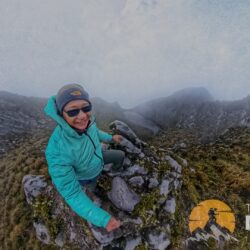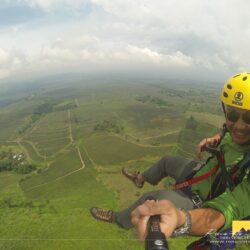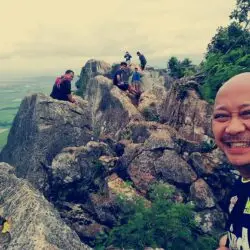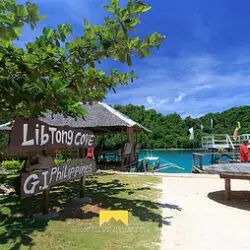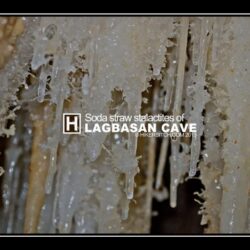“Another post on climb preparations?”
 Well, for one, people keep asking about how I prepare for climbs specific to an itinerary. Also, the recent accidents that brought havoc on my “less prepared” climbs made me swore compulsion on climb preparations. Lastly, another friend wanted a climb preparation meant for the newcomers, “not-so-fit”, and geek-trekker wanna be (like me).Now that the summer for climbing is here, I bet I’d receive some more prodding on how tos and what nots in trekking and climbing. So I’m giving this, updated, for the nth time.
Well, for one, people keep asking about how I prepare for climbs specific to an itinerary. Also, the recent accidents that brought havoc on my “less prepared” climbs made me swore compulsion on climb preparations. Lastly, another friend wanted a climb preparation meant for the newcomers, “not-so-fit”, and geek-trekker wanna be (like me).Now that the summer for climbing is here, I bet I’d receive some more prodding on how tos and what nots in trekking and climbing. So I’m giving this, updated, for the nth time.
Warning: This article is in no way a substitute to the formal climb preparations and fitness conditioning recommended by authorities on climbing. Precautions and consultations should be done with professional or experienced climbers prior to undertaking any pre-climb and climbing expeditions
- Identify measurable goals for the climb. Is it for fun, an introductory climb (first climb) or “bonding” climb with friends? Is this meant to be a training climb (for the mountain rats), an endurance climb or a race(called climbathon)? Or maybe a clean up drive or a tribute climb? Like any other undertakings, climbs should have goals that are realistic, attainable and measurable. This should guide you in every aspect of your preparation, climb and post climb activities. An example of a specific attainable goal is “I’d like 2-3 day traverse trek up Mt.Apo on a 20kg load, take photos, bond with nature and friends, go down on the other side, safe and without injuries”. The key is a specific, measurable goal. Unrealistic goals or “boasting” (which is a common mistake of newbies) about conquering heights and difficult trails is considered taboo and can only lead you to injuries.
- Choose your “mountain” and get your possible itineraries (IT) as early as you can and study it. Knowing the “what, where, when, and why” are you climbing will give you an idea as to “how” to climb. When I get the climb destination and IT, I study it it well and do research about the place– its terrain, weather patterns, dangers, flora and fauna as well as the inhabitants and the unique culture that is in it. Blending with this environment is your key to a successful and fun filled climb. The weather and terrain is extremely important, as this greatly affect the kind of gears your going to bring along during the climb. The net is full of information about so many places to climb (I compiled a list last year,here), PAGASA for the weather, Pinoy Mountaineer and Bundok Philippines for itineraries. At times, I find very nice places to go by asking fellow trekkers, reading travelogues and browsing pictures.
- Physically and emotionally prepare yourself for the planned climb. This will depend on the level of difficulty of the planned climb and your current health status. One’s easy mountain trek might be another mountaineer’s nightmare climb. Here’s my personal view on physical conditioning and fitness for mountaineers. As a general rule if you’re having health problems prior to the climb and have special health concerns you should ask your physician for an advice. The bottom line is you’ll have to sweat some sweats if you want to covers some trail distance.The less fit you are, the more “work outs” you need. Exercises that “simulate” trekking and climbing activities should be part of your training regimen. I have used this climb preparation regimen the first time I went to Mt. Apo. Though I survived that climb, I still panted the whole trek up! That’s where mental toughness came in and I was able to push through with the climb.Condition your mind to finish the trek.
- Prepare your climbing gears. This is where most newbies dwell much but fail more. Experienced climbers select and pack their gears fast and well, but that doesn’t mean a newbie is excused from packing gears “with common sense” at all. With discipline comes the eye for whats needed and whats not. I wrote a pretty expensive personal insight on climbing gears here, it should enhance your understanding of gear preparations for a specific climb.
- Stick to the basic climbing gears that is needed for your planned climb. To some degree, this is maybe too cumbersome if not painstakingly difficult. A good guiding principle I made for packing gears in climbing is “If I can live (comfortably) in the wilderness without this, I don’t need it.”
- “Pack light and pack it well” ( I wrote another post on backpacks and how to pack for climbing). Making all the necessary steps like waterproofing with a garbage bag and packing all the emergency stuff on top of your packs.
- Get (or borrow) gears that are durable enough for the climb but shallow enough for your pockets.
- Make sure that if your climbing with a group, you’re bringing in your share of climbing equipments and gears, like a tent or cook set perhaps.You need to inquire from the climb master or your group’s climb leader.
- I always make sure I have enough protection for cold and rainy weather, so a jacket and raincoat is a must for me.
- The Bundok website as well as Backpacking.net produced a sample of equipment checklist for 3-4 days- all season climb. I printed a copy and used it as my essentials checklist. I also searched the Northface and Habagat website for instructions how to use my gears and equipments and its safety profile.
- Mountaineering gears are a bit expensive, but if you are good at spotting high quality materials (even in the famed ukay-ukays) you’ll know this may not be the case always.
- Coordinate your group’s itinerary with the Local Government Unit (LGU) or DOT in charge of the campsite your heading to. Get necessary registration info and expenses, guides and porterage policies from them. Also inquire the needed transportation to and fro your jump off site.For some climbs that are usually organized by a host clubs, contact persons arrange for these registrations. It’s a must you know these details so you can prepare a backup plan for any eventually like an extra money and backup clothing.
- Call your climbing buddies and companions for this climb and plan out a full filing activity while staying at the campsite. Some climbers, plan a cooking session, others a mini BMC while some photo enthusiasts talk about outdoor photography. There are hundreds of things to do on a trek that I’m sure you’ll never ran out of ideas to ponder.Also, decide on what foodstuff to bring. Marketing early for your climb is a sign of a well prepared group climb. Getting hungry on a freezing environment is a lot to endure mind you.
- Review the “Leave No Trace” ethics in climbing. You can, in a simple way, help preserve our environment by applying these principles in climbing. And you will not look dumb up there by displaying how ignorant are your pretentious climb exploits.
- Read your BMC manual (if you have one), first aid guides, survival guides, and if you have time, read on special topics like “mountain sickness” and hypothermia. Bring your personal first aid kit .I noticed quite a few of mountaineers knew they were having symptoms of this illness while climbing.
Lastly, Go Climb. All these preparation mean nothing if you cannot implement it. Be there, be safe and have fun!



